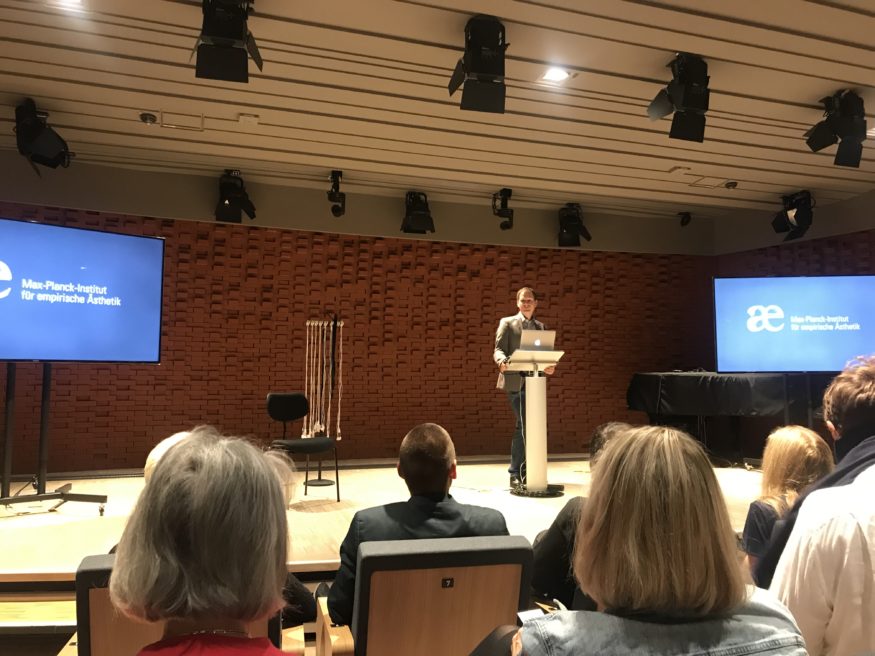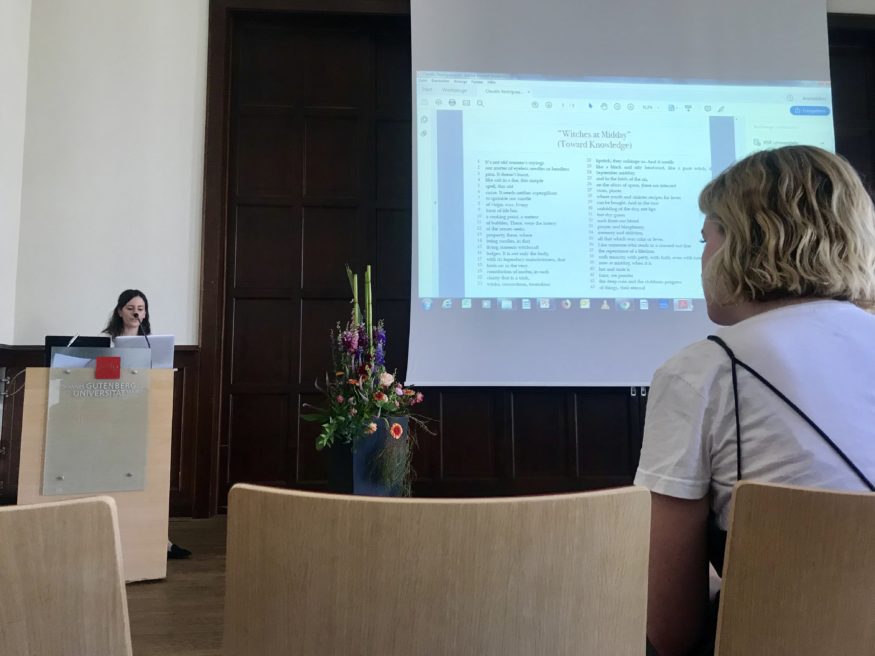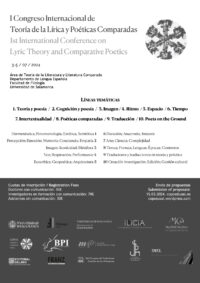
Tras los precedentes de Bangor, Durham, Oxford, Helsinki, Stony Brook y Canterbury, la edición 2019 del congreso Cognitive Futures ha tenido lugar en la Universidad Johannes Gutenberg de Mainz. Cognitive Futures es una red dinámica de investigadores internacionales interesados por el entrelazamiento interdisciplinar entre las ciencias cognitivas y las humanidades. En esta ocasión, las líneas centrales del congreso 2019 incluyeron diversos aspectos cognitivos de la experiencia estética, avances en estudios literario-evolutivos, las modalidades de la lectura, distintos aspectos de la cognición en las artes performativas, así como el papel de los valores en la inteligencia artificial. Asimismo, el congreso abordó cuestiones de metodología que pusieron de relieve diversas concepciones de los estudios cognitivo-literarios y el tipo de cuestionamientos epistemológicos a los que estos dan lugar. Se insistió tanto en los procedimientos analíticos de los textos literarios, como en la dimensión empírica de la investigación literaria (ver https://www.cognitive-futures.com).
A cargo del neurocientífico Gregory Hickok, la conferencia inaugural llevó por título «The Myth of Mirror Neurons» y cuestionó profundamente el uso sobredimensionado del concepto de las neuronas espejo como mecanismo de explicación para una diversidad de procesos cognitivos como la empatía o el reconocimiento, que no vienen respaldados por suficiente evidencia neurobiológica. Los procesos abordados por Hickok incluyeron también la lectura mental (mind-reading), en tanto que capacidad de reconocer comportamientos causados por estados mentales, y el proceso de imitación entendido como tendencia hacia la acción; Hickok considera que entendemos la acción porque la representación motora de dicha acción se activa en nuestros cerebros, pero para él el significado no se encuentra únicamente en el movimiento en sí, sino que este es contextualmente dependiente. La acción y la percepción están estrechamente unidas, pero es la acción la que está arraigada a nuestro entendimiento; Hickock aboga entonces por una teoría sensorial para la comprensión de la acción.
Entre la constelación de participantes se encontraban figuras con una notable trayectoria dentro de los estudios literarios interdisciplinares como Amy Cook o Lisa Zunshine, entre muchas otras. Partiendo del teatro griego clásico, pero desde el lado de la interpretación y no del propio texto literario, la primera de ellas definió y defendió la investigación humanística como un tipo de arqueología de tipo cognitivo, pues actuar es, ante todo, distanciarse de un sentido propio para construir y trasladar otro. Por su parte, Lisa Zunshine confrontó discursos procedentes del ámbito científico y literario y sus recepciones y lecturas por parte de un público a través de la «Teoría de la mente» o mind-reading, que promulga que en cualquier proceso de lectura e interpretación —ya sea en un contexto literario o en una interacción social ordinaria—, el ser humano infiere e identifica en su interlocutor estados mentales que se predican en términos de pensamientos, deseos o creencias. Si bien las Humanidades están atravesadas por una clara propensión a la inferencia de estos estados, Zunshine observa que al discurso científico actual empiezan a serle inherentes estas atribuciones intencionales.
Los estudios hispánicos contaron con una fuerte representación a través de los trabajos de Isabel Jaén Portillo y Julien Simon. La comunicación de este último tenía como corpus de estudio dos biopics centrados en Lope de Vega (en la película Lope de Andrucha Waddington) y Santa Teresa de Jesús (Teresa, el cuerpo de Cristo de Ray Loriga) y exploraba las posibilidades y los efectos generados en función de la perspectiva narratológica escogida: una que se ciñe a la propia vida del escritor y, por consiguiente, con un mayor peso del contexto biográfico y sociocultural de la época; u otra que privilegia la propia mente del escritor y sus emociones, dando paso a un mayor despliegue de la tarea creativa y visibilizando los procesos cognitivos y emocionales que conlleva. Isabel Jaén Portillo introdujo las Fictions of human development, es decir, las ficciones que dan muestra de la evolución de la mente humana en relación a un contexto físico, social e histórico. Para ello se centró en la obra de Don Quijote de la Mancha y, de manera más extensa, en el personaje de Sancho Panza, quien, conforme avanza la novela, se libera del paradigma animal (que lo vincula de manera muy estrecha con el cuerpo y que lo hace incapaz de organizar sus pensamientos o de entender las causas y explicaciones de un acontecimiento) y evoluciona hacia uno humano.
La participación del grupo ILICIA en el Congreso Cognitive Futures in the Arts and Humanities se ha materializado en las comunicaciones de Candela Salgado Ivanich y Víctor Bermúdez. La presentación de Víctor Bermúdez llevó por título «Gestures of the Self in Chantal Maillard: A Cognitive Poetic Approach». En ella, se parte de la consideración de que el acto creativo está unido a la representación del movimiento que conlleva la subsecuente identificación del sujeto en la escritura. Bermúdez sostiene que las imágenes mentales de la acción, el auto-reconocimiento, la consciencia del movimiento y la imitación pueden investigarse desde la perspectiva de la poética cognitiva, mediante la implementación de modelos de representaciones de acción en el texto poético. En este contexto, la noción de propiocepción permite una exploración interdisciplinar de las expresiones de la autoconciencia en la poesía de Chantal Maillard. Por su parte, Candela Salgado Ivanich en «Behind the Foot and Eye: Motion and Effects in Claudio Rodriguez’s Poetry» estudió un poema de Claudio Rodríguez, «Hechizo al mediodía», en el que se propone una suerte de definición de conocimiento. Primeramente, su análisis tomó en consideración las reflexiones textuales que se dan acerca del mismo para, a continuación, indagar en los mecanismos emocionales, kinéticos y kinestésicos del «yo-lírico» que subyacen en la construcción de su discurso y, por lo tanto, en la construcción de significados del mundo para este sujeto.
Ambas comunicaciones ilicianas entraron en resonancia, en cierta manera, con las presentaciones de Ioannis Sidiropoulos y de Karin Kukkonen. El primero de ellos se aproximó al movimiento, esta vez dentro del marco de la danza, e indagó en cómo reacciona y se muestra el cuerpo ante determinados sonidos. Siguiendo el Laban Movement Analysis, que no busca interpretar un movimiento sino describir su expresión, Sidiropoulos evidenció, a través de una serie de experimentos realizados en el desarrollo de su Tesis Doctoral, de qué manera la familiarización o su ausencia respecto de un sonido vehicula variaciones en cuanto a la fuerza, la forma, el espacio o la concepción del cuerpo propio. Por otro lado, Kukkonen partió del célebre inicio de L’étranger de Albert Camus, que instala una cierta sensación de extrañeza ligada a la elección del tiempo verbal dentro de la frase « Aujourd’hui maman est morte », para observar el tipo de impacto que estas atmósferas de rareza generan en la experiencia corporal del lector a un nivel exteroceptivo e interoceptivo. Por su parte, Stefan Blohm sistematizó un sintético estudio empírico sobre el ritmo en diversas tradiciones literarias como un rasgo perceptualmente computarizable de las estructuras poéticas. Basado en un corpus literario diacrónico en lengua inglesa y alemana, Blohm estudia quince esquemas rítmicos del cuarteto a partir de la velocidad de reacción de sus lectores en los que identifica principios de la Gestalt susceptibles de ser relacionados con efectos estéticos.
Max Planck Institute for Empirical Aesthetics
El congreso incluyó la visita al Max Planck Institute for Empirical Aesthetics, cuyo propósito fue la familiarización con la investigación, infraestructura y metodología de los laboratorios del MPIEA. Actualmente el instituto desarrolla su investigación en una estructura tripartamental: Lenguaje y literatura, Música y Neurociencia. Su objetivo central es el estudio de «los mecanismos, los generadores y las funciones del gusto estético y las preferencias estéticas» (ver https://www.aesthetics.mpg.de/). En este puntero centro de Frankfurt se realizan estudios de seguimiento de ojos (eye tracking) con el propósito de evaluar los procesos de atención en la lectura, la gesticulación facial durante la contemplación de obras de arte, las reacciones del sistema nervioso y el flujo sanguíneo durante la proyección de filmes y la escucha de conciertos. En el MPIEA se estudia quién aprecia qué, por qué y bajo qué condiciones ahondando en «la naturaleza del “placer estético” y los diferentes tipos de atractivo estético y “emociones estéticas”». Se trata de un singular centro interdisciplinar donde se brinda una base científica a la investigación de la estética, sin perder de vista la relevancia de la filosofía, los estudios literarios o la historia y teoría del arte sobre la creatividad y la imaginación.
El congreso Cognitive Futures 2019 se cerró con una sesión plenaria de intercambio entre los asistentes y comunicantes y los organizadores. El objetivo fue el de recoger las distintas impresiones surgidas a lo largo del congreso, así como orientarse hacia el futuro, contemplando diversas maneras para fortalecer la red, garantizar instalaciones que permitan realizar performances y pasar el testigo a universidades que quieran acoger por primera vez las próximas ediciones.
English version
After the precursors at Bangor, Durham, Oxford, Helsinki, Stony Brook and Canterbury, the 2019 Cognitive Futures conference was held at the Johannes Gutenberg-University of Mainz. Cognitive Futures is a dynamic network of researchers who are interested in the interrelationship between cognitive sciences and the Humanities. On this occasion, the focus of the 2019 conference included several cognitive aspects of aesthetic experience, advances of studies of literary evolution, the modalities of reading, different aspects of cognition in performative arts, and the role values play in artificial intelligence. Apart from this, the conference dealt with methodological issues which emphasized several conceptions of cognitive literary studies, as well as the kind of epistemological challenges resulting from these studies. Strong emphasis was placed as much on the analytical procedures as on the empirical dimension of literary research (see https://www.cognitive-futures.com).
The inaugural conference, held by neuroscientist Gregory Hickok, was titled “The Myth of Mirror Neurons” and deeply questioned the excessive use of the concept of mirror neurons as an explanation mechanism for a range of cognitive processes, such as empathy or recognition, which are not sufficiently supported by neurobiological evidence. The processes Hickok addressed also included mind-reading, just as the ability to recognize behaviour caused by mental states, and the process of imitation understood as a tendency towards action. Hickok assumes that we understand an action because its motor representation is activated in our brains, but, in his opinion, the meaning lies not only in the movement itself, but it depends on the context. Action and perception are closely intertwined but action is the one crucial to understanding. Thus, Hickok argues for a sensorial theory for understanding action.
Several researchers with remarkable experience in the field of Interdisciplinary Literary Studies were among the participants of the conference, for example, Lisa Zunshine, Amy Cook and many others. Resting upon classical Greek theatre, but seen from the side of interpretation and not the literary text itself, the first of them defined and defended humanistic research as a cognitive archaeology, given that acting primarily means gaining distance from one sense in order to construct and transfer another. Lisa Zunshine, for her part, opposed discourses from the scientific and literary field with their receptions and readings by an audience by means of the “theory of mind” or mind-reading, which indicates that in every process of reading and interpretation —in a literary context as well as in ordinary social interaction— the human infers and identifies mental states in his interlocutor which become manifest in terms of thoughts, wishes or beliefs. Although the Humanities are imbued with a clear propensity towards the inference of such states, Zunshine observed that these intentional attributions start to be inherent to present-day scientific discourse.
The Spanish studies were strongly represented by Isabel Jaén Portillo’s and Julien Simon’s work. The latter one’s communication dealt with two biopics focusing on Lope de Vega (in the movie Lope, by Andrucha Waddington) and Santa Teresa de Jesús (Teresa, el cuerpo de Cristo, by Ray Loriga) and explored the potential of and effects generated by the chosen narratological perspective: one limited to the writer’s life, having consequently greater weight in the cultural context of the epoch; or the other, privileging the writer’s own mind and his emotions, allowing a greater deployment of the creative task, and making visible the cognitive and emotional processes involved by this. Isabel Jaén Portillo introduced the Fictions of Human Development, i.e. fictions which show the evolution of the human mind in relation to a physical, social and historical context. For this purpose, she focused on Don Quijote de la Mancha and, more extensively, on the character Sancho Pansa, who frees himself from the animal paradigm (which ties him very closely to the body and incapacitates him from organizing his thoughts or understanding the reasons and explanations for events) and develops towards a human one as the novel advances.
The participation of the ILICIA cluster at the Cognitive Futures Conference in the Arts and the Humanities consisted in the communications by Candela Salgado Ivanich and Víctor Bermúdez. The presentation by Víctor Bermúdez was titled “Gestures of the Self in Chantal Maillard: A Cognitive Poetics Approach”. He rested upon the assumption that the creative act is tied to a representation of movement which involves the subsequent identification of the subject in the text. Bermúdez argued that mental images of action, self-recognition, consciousness of movement, and imitation can be examined from the cognitive poetics perspective by implementing models of action representation in the poetic text. In this context, the notion of proprioception offers the possibility of an interdisciplinary exploration of how self-awareness is expressed in the poetry of Chantal Maillard. Candela Salgado Ivanich, for her part, examined in “Behind the Foot and Eye: Motion and Effects in Claudio Rodriguez’s Poetry” a poem by Claudio Rodriguez, “Hechizo al mediodía”, in which some kind of a definition of knowledge is proposed. First, her analysis took the textual reflections about the poem into account in order to then delve into the emotional, kinetic and kinaesthetic mechanisms of the “lyric-I” that form the basis of the subject’s construction of discourse and consequently of the construction of meaning of the world for it.
Both Ilician contributions, in a way, resonated with the presentations by Ioannis Sidiropoulos and Karin Kukkonen. The first of them approached movement too, but in the framework of dance, and explored how the body responds and reacts to specific sounds. Following the Laban Movement Analysis, which does not seek to interpret a movement, but to describe its expression, and drawing upon a series of experiments carried out while working on his PhD Thesis, Sidiropoulos showed how the familiarization with or the absence of a sound leads to variations regarding the strength, form, space or conception of the body. Kukkonen, for her part, rested upon the well-known beginning of L’étranger by Albert Camus, which evokes a certain feeling of confusion caused by the choice of verb tense in the sentence “Aujourd’hui maman est morte”, in order to observe the kind of impact these atmospheres of strangeness have on the reader’s corporal experience on an exteroceptive or interoceptive level. Stefan Blohm systematized a synthetic empirical study on rhythm in different literary traditions as a perceptually computerizable feature of poetic structures. Based on a diachronic literary corpus in English and German language, Blohm examines fifteen rhythmic patterns of quatrain through the response time of people reading them. For these patterns, he identifies Gestalt principles which are susceptible of being related with aesthetic effects.
Max Planck Institute for Empirical Aesthetics
A visit to the Max Planck Institute for Empirical Aesthetics took place as part of the conference, whose aim was to familiarize the participants with research, infrastructure and methodology of the laboratories of the MPIEA. At present, the institute carries out research in a tripartite structure: Language and Literature, Music, and Neuroscience. The main objective is to explore “mechanisms, elicitors and functions of aesthetic liking and aesthetic preferences” (see https://www.aesthetics.mpg.de/). The research conducted at Frankfurt’s leading centre includes studies of eye tracking to evaluate processes of attention while reading, studies of facial gesticulation during the contemplation of art works, and studies of reactions of the nervous system and blood circulation while watching movies or listening to concerts. At the MPIEA it is investigated who appreciates what, for which reasons and under which conditions, looking into “the nature of «aesthetic pleasure» and the different types of aesthetic appeal and «aesthetic emotions»”. It is a singular interdisciplinary centre where a scientific base for the investigation of experience is provided without losing sight of the importance of philosophy, literary studies, or the history and theory of art for creativity and imagination.
The 2019 Cognitive Futures Conference ended with a plenary meeting of exchange between attendees, contributors and organizers. The aim was to collect different impressions gained in the course of the conference, as well as an orientation towards the giving consideration to various possibilities to strengthen the network, to guarantee installations which permit the realization of performances and to share experience with universities that want to host future versions of the conference.
Víctor Bermúdez & Candela Salgado
Traducción por/Translation by Friederike Foedtke









